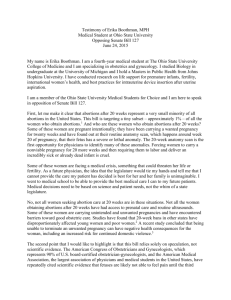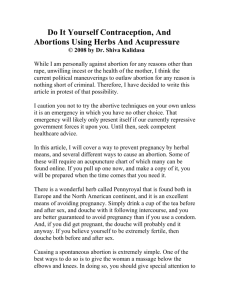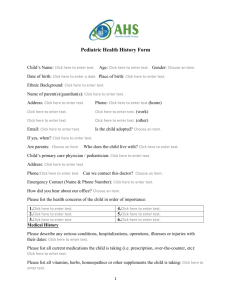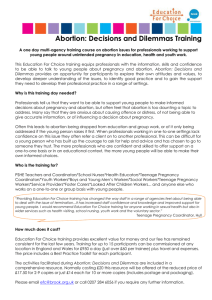Infertility, Pregnancy Termination and Loss
advertisement
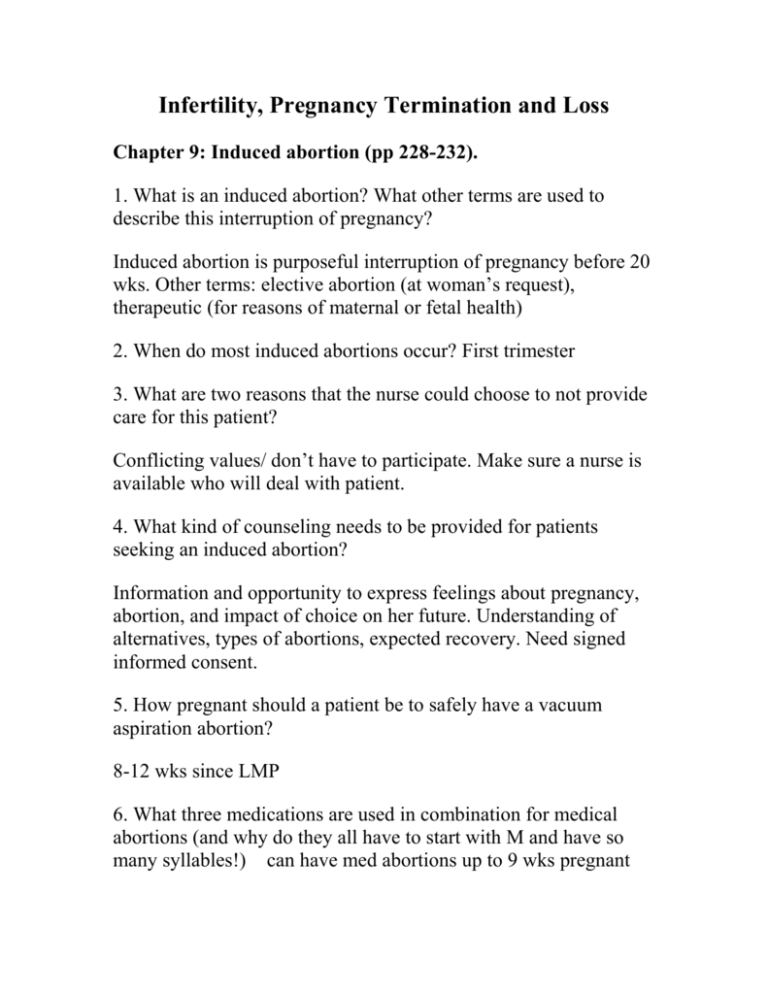
Infertility, Pregnancy Termination and Loss Chapter 9: Induced abortion (pp 228-232). 1. What is an induced abortion? What other terms are used to describe this interruption of pregnancy? Induced abortion is purposeful interruption of pregnancy before 20 wks. Other terms: elective abortion (at woman’s request), therapeutic (for reasons of maternal or fetal health) 2. When do most induced abortions occur? First trimester 3. What are two reasons that the nurse could choose to not provide care for this patient? Conflicting values/ don’t have to participate. Make sure a nurse is available who will deal with patient. 4. What kind of counseling needs to be provided for patients seeking an induced abortion? Information and opportunity to express feelings about pregnancy, abortion, and impact of choice on her future. Understanding of alternatives, types of abortions, expected recovery. Need signed informed consent. 5. How pregnant should a patient be to safely have a vacuum aspiration abortion? 8-12 wks since LMP 6. What three medications are used in combination for medical abortions (and why do they all have to start with M and have so many syllables!) can have med abortions up to 9 wks pregnant Methotrexate: cytotoxic that causes early abortion by blocking folic acid so fetal cells can’t divide. given IM or orally Misoprostol (Cytotec): prostaglandin analog that softens and dilates cervix and stimulates uterine contractions. Given vaginally 3-7 days after Methotrexate. Mifepristone (RU 486): blocks action of progesterone. Given orally, taken up to 7 wks 7. In general, who are the "best" candidates for medical abortions (this is an opinion question based on the info you have just read!) 8. When is a D&E performed? Up to 20 wks, most commonly performed betw 13-16 wks Chapter 10 Infertility 1. How common is infertility? 10-15% reproductive age couples 2. What percentage of time is infertility due to female factors, male factors and unexplained factors? F=40%, M=40%, Both=20%, unexplained=20% 3. You are the charge nurse at an infertility clinic. It is your responsibility to schedule various infertility tests. Look at Table 10-1 on p. 240. A woman calls to schedule these tests. Her LMP is November 1st and she always has a 28 day cycle (fat chance!). When would you schedule these various tests? Hysterosalpingogram: Nov. 8-11 Postcoital test: Nov. 10-12 Sperm immobilization antigen-antibody rxn, assessment of cervical mucus: Nov. 14-16 Ultrasound dx of follicular collapse: Nov. 14-16 Serum assay of plasma progesterone: Nov. 21-26 Endometrial biopsy: Nov. 22-28 Chapter 10: Adoption A married couple is considering adoption after five years of infertility treatments. They had one SAB 1 ½ years ago. The woman is 42 and the man is 55. She would like to try one more shot at IVF (they have had three previous attempts without success) and he is ready to adopt. How would you assist them with the five emotional stages that contemplating adoptive parents may use to assist in their decisions? Have info on options for adoption available, refer to community resources Chapter 31 pp. 804-815 1. What are some causes of spontaneous abortions (SAB:early miscarriage) happens before 12 wks. 50% chromosomal abnormalities, endocrine imbalance (DM type 1), immune immunologic factors, infection, systemic disorders, systemic disorders, genetic factors. 2. Look at table 31-1 p. 807. What are the differences among threatened, inevitable and incomplete, complete, missed and septic SABs? type amt. bleeding uterine cramps pass tissue dilate threatened slight, spotting inevitable moderate incomplete yes, cervix complete mild mild to severe heavy, profuse slight missed none, spotting septic usually varies, smells severe no no no yes yes w/tissue in mild yes no none no no varies varies recurrent (three or more consecutive abortions) varies varies yes usually 3. How are the symptoms different among threatened, inevitable and incomplete SABs? Why would it be important that we accurately gather information from the patient about her symptoms? knowing how to treat: bed rest not effective, but placebo affect is. Women need to think they did everything possible to avoid threatened abortion or they feel guilty. 4. What do HcG levels do at the start of a pregnancy? levels double every 1.4-2 days until about 60-70 days 5. So what’s an incompetent cervix (could they have named it anything more degrading to a woman’s concept of her ability to carry a child)? A cervix that dilates prematurely, usually after 20 wks, and doesn’t hold the pregnancy. Scar tissue can weaken tissue or cervix won’t open 6. What are the signs of an ectopic pregnancy? What are the major risks? What other conditions can this life threatening pregnancy look like? can be misdiagnosed as UTI, PID, salpingitis, appendicitis, all kinds of stuff. 10% of maternal morbitity due to hemorrhage from ectopic pregnancy. missed period, adnexal fullness, tenderness-tubal pregnancy pain progresses from dull to colicky pain when tube stretches pain may be unilateral, bilateral or diffuse over abdomen. Dark red or brown abnormal vaginal bleed in 50-80% women Ectopic rupture: increase in pain, may be generalized or acute lower abdomen. Referred shoulder pain (diaphragmatic irritation from blood in peritoneal cavity). May show signs of shock related to amt of bleeding. Ecchymotic blueness around umbilicus (cullen’s sign) 7. What is the major physical risk with a hydatidiform mole? We already discussed previas and abruptions. Just remember to be aware these can occur anytime, but are most likely to occur in the third trimester. Weird tissue that develops; uterus grows too fast, can present with HTN. is rare; complete: sperm and empty ovum; choriocarcinoma can develop. Partial: normal ovum and 2 sperm anemia from blood loss, n/v, abdominal cramps. At risk for persistent trophoblastic disease requiring chemotherapy (in complete). Choriocarcinoma can go to lungs. 8. What are dermoid cysts? p. 282 germ cell tumors, usually occurring in childhood. contain hair, teeth, sebaceous secretions, and bones. Chapter 41 1. How can having a miscarriage affect a mother and a father? Look at Box 41-1 p. 1092 as an overview. phases of parental grief: acute distress, intense grief, reorganization period of mourning before can move on 2. What is the technical difference between miscarriage, fetal death, stillbirth, and newborn death? when it happens: miscarriage early 1st trimester, fetal death later, stillbirth you carry to term and baby born dead, newborn death is after live delivery. 3. Name three phases of grief and list at least 2 characteristics of each phase. 1) acute distress: shock, numbness, intense crying, depression 2) intense grief: loneliness, emptiness, guilt, anger, anxiety, diorganization 3) reorganization: search for meaning, reduction of distress, reenter normal life with more enthusiasm 4. Name 4 important assessments when working with a family which has experienced a perinatal loss. 1) nature of parental attachment, meaning of pregnancy, related losses 2) circumstances surrounding the loss 3) immediate response of mother and father to the loss, whether are complementary or problematic, how responses match past experiences, personalities, and behavioral and cultural backrounds. 4) social support network and extent activated 5. Name 5 nursing interventions when working with a family which has experienced a perinatal loss. 1) help mother, father and other family members actualize loss 2) help parents with decision making 3) help acknowledge and express feelings 4) normalize grief process and facilitate positive coping 5) meet physical needs of postpartum bereaved mother 6) What are the pros and cons of autopsy? 7. How would you use the Perinatal Grief Scale on page 1095? If someone is having difficulty articulating feelings, could use scale to ask questions, to put words to feelings difficult to express 8. Putting a baby up for adoption doesn’t seem to be in our text so I am including it here because it is also a loss of a newborn for the woman and her family who is choosing to relinquish her child. Look back through this chapter form the perspective of assisting this patient with her loss. What might her (their) grief response be? Guilt, feeling inadequate, anxiety about choice

